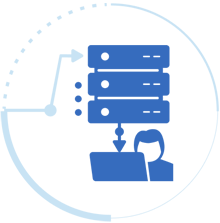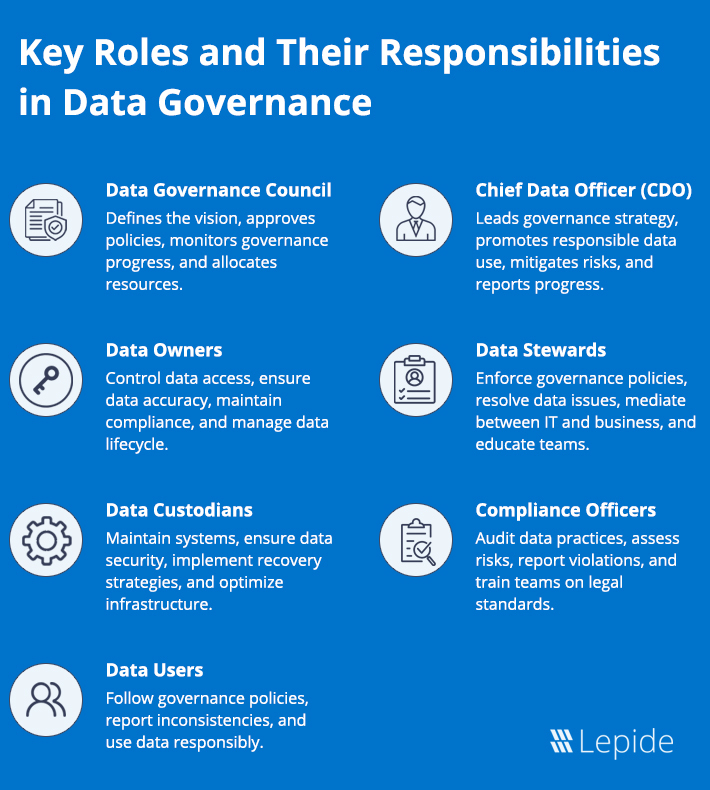Last Updated on December 11, 2024 by Satyendra

Data governance can be described as being the genetic makeup of an organization’s approach to data management. Every position in it provides a gene that sustains its organism and socio-organizational viability. While there is one missing or dysfunctional, the whole organism and its internal processes are negatively affected. This blog specifically emphasizes the highly important elements of a successful data governance program, why these elements are crucial, and how one can assign them for successful operation.
Data governance roles are more than just positions; they are points of responsibility where your organization’s data continues to be accurate, protected, and available. Duties extend from determining how an organization should manage data down to developing a set of methodologies for confirming the data management governance directives every business day. Both of these roles are multi-layered, encompassing senior executives, policymakers, and line managers on the one hand, and enforcers, implementers, and prosecutors on the other.
The goal of defining these roles is simple but powerful: develop a culture of distributed accountability in which a data issue does not become ‘everybody’s fault’ but that of a professional data scientist. This may lead to inefficient and ineffective governance, non-adherence to policies and weaker compliance measures, and in the end loss-making scenarios.

Key Roles and Their Responsibilities in Data Governance
The development of the data governance framework requires key personnel or employees and everyone engaged needs to have specific responsibilities. Let’s break these down:

1. The Data Governance Council
The Data Governance Council is the ultimate governance decision-maker of governance initiatives. This team comprises executors, department directors, and legal consultants who monitor governance policies from an organizational perspective.
Responsibilities:
- Set the Vision: Setting out for overall strategy of the organization in governing data to ensure that it achieves its business strategies.
- Approve Policies: Setting standards on who should have the data, how the data should be collected, free from what, and any standards that can be set on the data.
- Monitor Implementation: Coordinating KPIs means monitoring the outcomes of governance work.
- Resource Allocation: Proactive provision of department resources, employees, and financial resources to accomplish work objectives.
If they don’t have a council then it is probably marginalized where individuals working on the issue do not necessarily have a clear path that they have to follow.
2. Chief Data Officer (CDO)
The most important role in the system of data governance is attributed to the Chief Data Officer. Not only providing a map for decision-makers, the CDO also serves as an advocate for bringing those decisions to life at the ground level.
Responsibilities:
- Policy Development: Creating and implementing the framework of data governance.
- Evangelizing Governance: Raising awareness of how everyone in the organization should use data both responsibly and effectively.
- Risk Mitigation: Identifying and preventing data handling risks and threats.
- Metrics Reporting: Reporting on the assessment of the progress made in the governance to the council at least once in a term.
The position of the Chief Data Officer is instrumental in turning the theoretical aspect of governance into a practical reality.
3. Data Owners
A data owner is normally an organizer of a department or an individual who has the power to make decisions concerning a given dataset.
Responsibilities:
- Access Control: Determining which Employee, group, department, or individual can have input on, edit, or output data.
- Data Integrity: Being responsible for keeping the data they oversee as updated as possible.
- Regulatory Compliance: Making sure the data they handle complies with the laid down legal requirements.
- Data Lifecycle Management: Managing data from the time it is generated up to when it is deleted.
Data owners can be thought of as the owners of specific data or data assets like one might refer to a landlord as the owner of a piece of land. They guarantee that the asset is properly maintained and only accessible to the “approved” occupants, or “tenants.”
4. Data Stewards
Data stewards are the individuals who physically implement governance policies throughout the organization. They ensure that the directions of the data owners are fully executed.
Responsibilities:
- Quality Assurance: Ongoing checks and corrections of data-related discrepancies.
- Policy Implementation: Implementing governance rules to convert the rules into reality.
- Collaboration: Serving as the IT subject matter expert that mediates between the IT technical teams and other business segments dealing with data problems.
- Education: Teaching workers how they should appropriately handle data.
Focusing on data owners to get it done is less effective, yet stewards remain responsible for doing the ‘heavy lifting’ that ensures policies remain adhered to.
5. Data Custodians
The technical professionals from information technology departments or sections are usually responsible for managing data assets or data custodians.
Responsibilities:
- System Maintenance: Maintenance of databases, data lakes, and platforms.
- Security Implementation: Having a positive attitude towards Encrypted systems, Firewalls, and Access control.
- Backup and Recovery: Designing strategies, processes, and policies that will guard against accidental or malicious destruction or alteration of information.
- Optimization: Maintaining the infrastructural efficiency for data-extensive tasks is another area of focus.
Governance policies are supported by the custodians with the technical infrastructure to enhance their functionality.
6. Compliance Officers
Compliance officers are the conscience of governance since they are responsible for checking whether companies’ standards are in line with the law.
Responsibilities:
- Policy Audits: GDPR for example requires companies to review data governance practices in a bid to align them with these laws.
- Risk Assessments: Gaps in compliance with set regulations
- Reporting Violations: Reporting to the governance council when there are such breaches as discussed above.
- Training: Advising the teams on legal requirements on how to handle the collected data.
Their function is to prevent the organization from being fined, sued, or its reputation tarnished in some way.
7. Data Users
Finally, there are data users and employees who interact with data regularly. They may not have formal governance roles, but their behavior has a direct impact on governance outcomes.
Responsibilities:
- Adherence: Following policies on data access, usage, and sharing.
- Flagging Issues: Reporting errors or inconsistencies in datasets.
- Ethical Practices: Using data responsibly and within policy limits.
Data users form the grassroots level of governance, translating policies into day-to-day action.
How to Assign Responsibilities Effectively
The best-established roles are useless without proper planning in place to ensure success. Here’s how to ensure accountability and collaboration:
- Document Responsibilities Clearly– There is a need for a governance charter to define every single post and its mandate. The general directions for governance-related inquiries should be sought from this document only.
- Leverage Cross-Functional Teams- Data governance isn’t an exclusive IT undertaking. Involve members from the marketing team, legal, financial teams, and reporting teams, so that you get a broad view.
- Invest in Training– The governance policies may take time to understand at some times. Daily office sessions along with many recourses guarantee everyone starting from stewards and ending with final consumers has the necessary understanding of their obligations.
- Establish Feedback Loops– Governance is not static. Regularly update the company’s functions and duties in job descriptions for changes in business and growth in technologies.
- Automate Wherever Possible– Applications such as data catalogs, lineage trackers, and audit logs, can help to assist and unload such roles to allow teams to work on higher-level tasks.
How Lepide Helps with Data Governance
Lepide Data Security Platform helps organizations streamline their data governance processes by automating tasks like data discovery, classification, and access control, ensuring compliance with data regulations. By monitoring user activity and generating insightful reports, Lepide helps organizations protect sensitive data, mitigate risks, and make informed decisions.
Conclusion
Role definition and assignment for data governance is not just administrative work but serves as the groundwork for data management at scale, and with compliance. Each of the tactical levels – the leaders, the strategic council, the operating staff, the corporate memory team – has a part to play and a part to win in the process of molding the raw material of data into the trusted asset.
A good framework does not just minimize compliance failures or threats by acting as a shield. It empowers an organization to make use of big data potentially for key decision-making and improved competitive advantage.
As you build or refine your governance strategy, remember that management is not about compliance; it is about accountabilities. So when everyone knows their part of the story, this is when the data ecosystem blooms.
If you want to know more about how Lepide can assist you further in data governance, feel free to schedule a demo with one of our engineers today!


 Group Policy Examples and Settings for Effective Administration
Group Policy Examples and Settings for Effective Administration 15 Most Common Types of Cyber Attack and How to Prevent Them
15 Most Common Types of Cyber Attack and How to Prevent Them Why AD Account Keeps Getting Locked Out Frequently and How to Resolve It
Why AD Account Keeps Getting Locked Out Frequently and How to Resolve It
